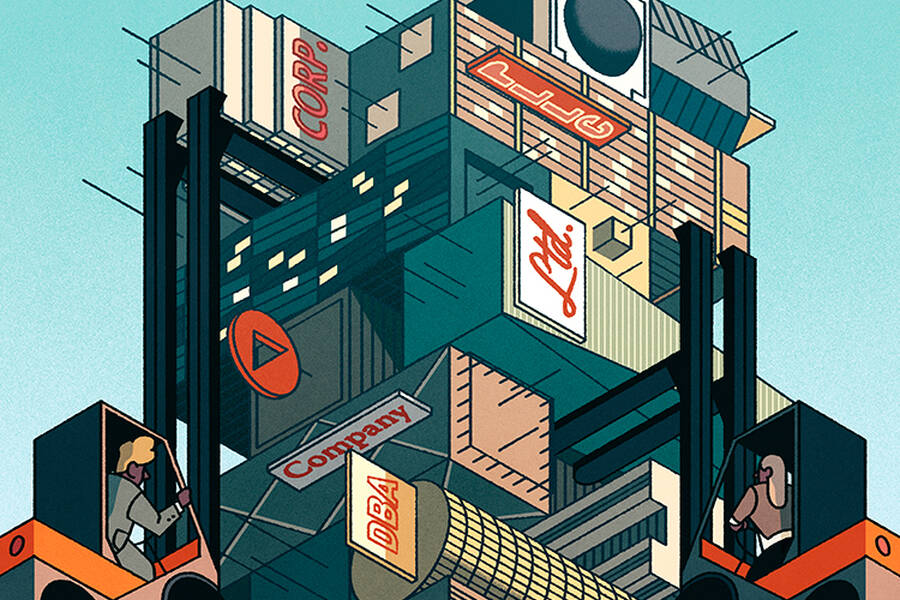Organizations Strategy Policy Jan 7, 2019
How to Navigate a Vertical Merger after the AT&T and Time Warner Ruling
Here’s what companies can do to minimize antitrust concerns in an uncertain regulatory environment.
For many years, an expedient way for companies to increase their size and scope has been to engage in horizontal mergers and acquisitions: purchase a competitor and just like that the firm will have increased its market share.
But the recent trend of consolidation in many industries—from banking to airlines to healthcare—has left companies looking to grow further with no competitors left to buy.
“A great example is Boeing,” says R. Mark McCareins, a clinical professor of business law and codirector of the JDMBA program at Kellogg. “As the primary commercial aircraft manufacturers in the U.S., domestic horizontal competitors are few and far between, so if they’re going to scale their business, they have to look either upstream or downstream for merger candidates.”
Vertical mergers—which combine companies that produce separate offerings along the supply chain of a final product—can provide access to new technologies, reduce costs, and increase efficiency.
They can also draw interest from the Federal Trade Commission and the U.S. Department of Justice’s Antitrust Division, which review proposed transactions for antitrust violations and potential anticompetitive effects. Recently, the Justice Department took action against the $85 billion merger of AT&T and Time Warner, alleging that the merged entity could raise both costs for competitors and prices for customers. A federal judge struck down the argument, but the case—now in federal appeals court—has had an unintended effect.
“There are a many companies that are looking at the same sort of vertical deals but have seen the government’s approach in AT&T–Time Warner, and as a result they are a little concerned,” McCareins says. “They don’t want to make this type of commitment in terms of legal fees and lost opportunity costs. Instead, companies are sitting on the sidelines waiting to see how this case is decided. Maybe as importantly, they are anxious to see if the government will publish some rules on how it will evaluate vertical deals going forward.”
But even in the current, uncertain regulatory environment, McCareins says, there are things companies considering a vertical merger can do to improve their chances of success of regulatory clearance.
Document Why the Merger Is Pro-Competitive
If a company is stagnant and its management wants to purchase a second firm whose technology could jump-start growth—and the first company’s board agrees to the acquisition—the acquirer needs to start documenting their pro-competitive justifications for the deal as early as possible, McCareins says.
Since one of regulators’ concerns will be the competitive harms that can result from the proposed transaction, executives from companies considering vertical mergers need to document fully and clearly why the potential deal will promote competition and enhance efficiencies. Doing so means that, when the company submits its required Hart-Scott-Rodino (“HSR”) filing announcing the deal, there is already clear documentary support for the merger’s pro-competitive benefits. Preparing this documentation only after a government inquiry into the transaction is not a preferred approach.
“[Companies] are anxious to see if the government will publish some rules on how it will evaluate vertical deals going forward.”
“Even if there is a government inquiry in the early stage of the HSR process,” McCareins says, “the business parties can point to these contemporaneous business documents to illustrate, ‘we’re not doing this deal for illicit reasons. We’re doing it to make our overall product better and to enhance consumer welfare.’”
Having the documents reassures regulators that the motivation for the deal is justified, an issue that popped up in the AT&T–Time Warner case. When government officials flagged the merger and requested additional information, it sent both companies scrambling, spending months and tens of millions of dollars to create the supporting documentation for litigation.
“If you’re creating those documents after you’ve had a government challenge, the government looks at them with a lot more suspicion and skepticism,” McCareins says, “and rightfully so.”
Hire a Structural Economist to Provide Market Insight
Companies should also hire a structural economist who can look at how the new company will fit within the market and what benefits it will reap moving forward.
“Economists provide insights that lawyers and business people do not have,” McCareins says. “It is advisable to get those viewpoints collected earlier rather than later.”
An outside economist can quickly assess the competitive landscape, analyze the proposed transaction, and make some insightful observations on how the deal with improve, not impair, the competitive balance in the broader market. In addition, the economist can assist the business parties with anticipating how the market may look in the next few years and how this particular deal will advance the acquiring firm’s ability to compete in a changing marketplace.
If the government challenges the deal, the FTC and Justice Department’s antitrust divisions will have their own economists ready to theorize on the merger’s anti-competitive implications.
“If you haven’t properly vetted or fleshed out the economic reasons for the deal in advance, let alone how the market will operate with the merged entity, the merging parties will be behind the 8 ball when compelled to quickly respond to the government economists.”
For example, when United and American Airlines invested heavily in the development of their own computerized reservations systems (CRS), they faced regulatory questions about whether they were creating an unlevel playing field. Both companies brought in ouside economists to respond to the antitrust division of the Department of Justice after realizing that without such economic firepower, their CRS would have been hard-pressed to withstand the challenge.
Assess and Analyze the Merger’s Effect Abroad
While due diligence and corporate governance are baked into the internal merger review process, many companies do not pay enough attention to a deal’s global implications.
This is a big mistake, says McCareins. “If you have a merger that has effects on commerce abroad—even if the merger is between two U.S. companies—it’s very likely the parties to the transaction will have to to make the same sort of competition filing in another jurisdiction.”
Companies are responsible for knowing what countries require filing for the deal, the timeline for that process, and the requirements they must meet to get clearance. If just one of the involved countries rejects the merger, McCareins says, the deal may not go through.
The European Union held up the recent $66 billion Bayer–Monsanto merger after realizing the deal would give the new company and two other agricultural-chemical giants—ChemChina and DowDuPont—a majority share in the global seed and pesticide markets. The deal went through only after the German-based Bayer and U.S.-based Monsanto agreed to divest more than $7 billion in assets to a competitor, the German firm BASF.
“Those foreign competition agencies demanded certain divestiture to make that deal work,” McCareins says. “So even if you get clearance in the U.S., you’ve got to prepare for similar problems from other enforcement agencies.”
McCareins is optimistic that clear regulations and guidelines on how to execute vertical mergers are forthcoming, either through rulings in the AT&T–Time Warner case or from either the Federal Trade Commission or the Antitrust Division of the Justice Department. But until the U.S. government provides that roadmap, the onus is on companies to prepare for any and all contingencies.
“There’s just too much uncertainty in the area given that business growth and scaling is a very critical component of a growing economy,” he says. “If companies are concerned that a potential vertical-merger challenge could hold a deal hostage, let alone force abandonment of such a deal, firms need guidance to account and plan for such a contingency. The lack of published guidelines on vertical alliances today needs to be rectified promptly by the U.S. competition enforcement agencies.”



